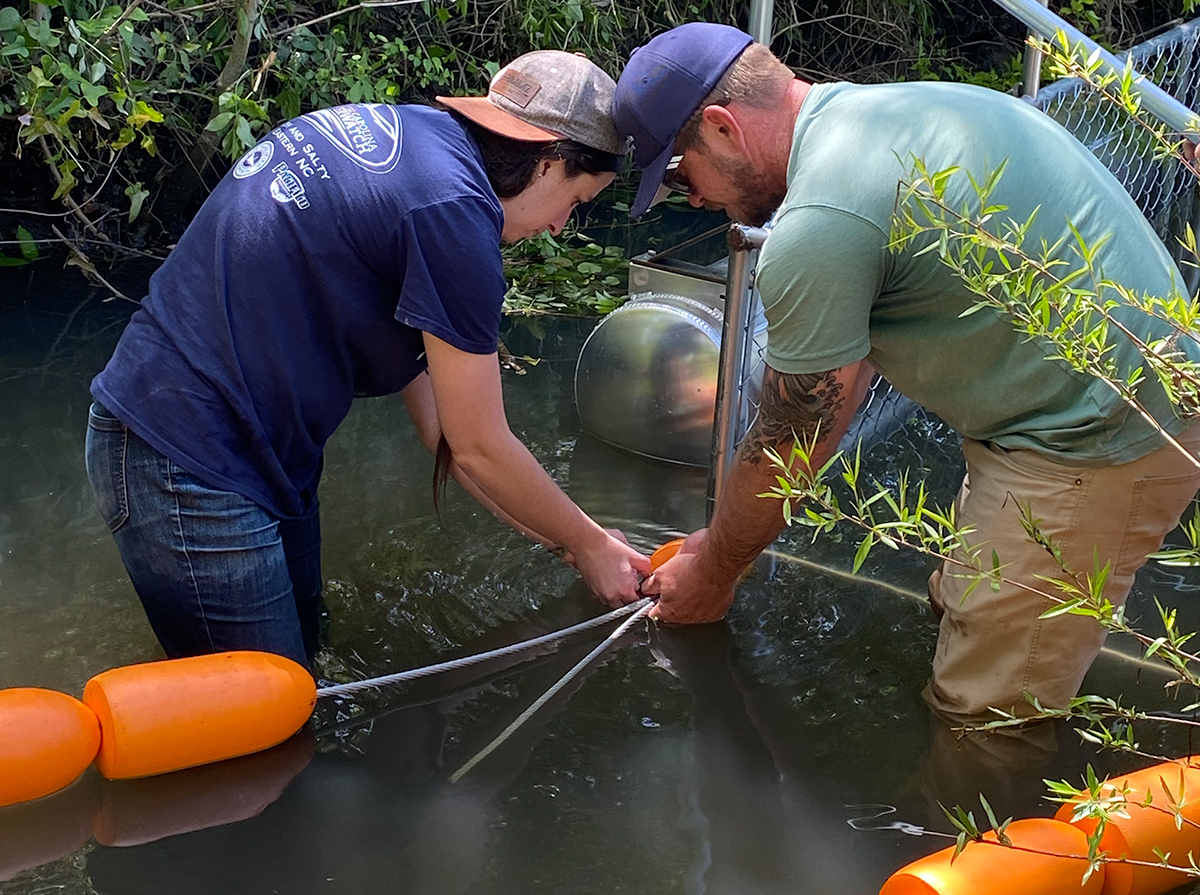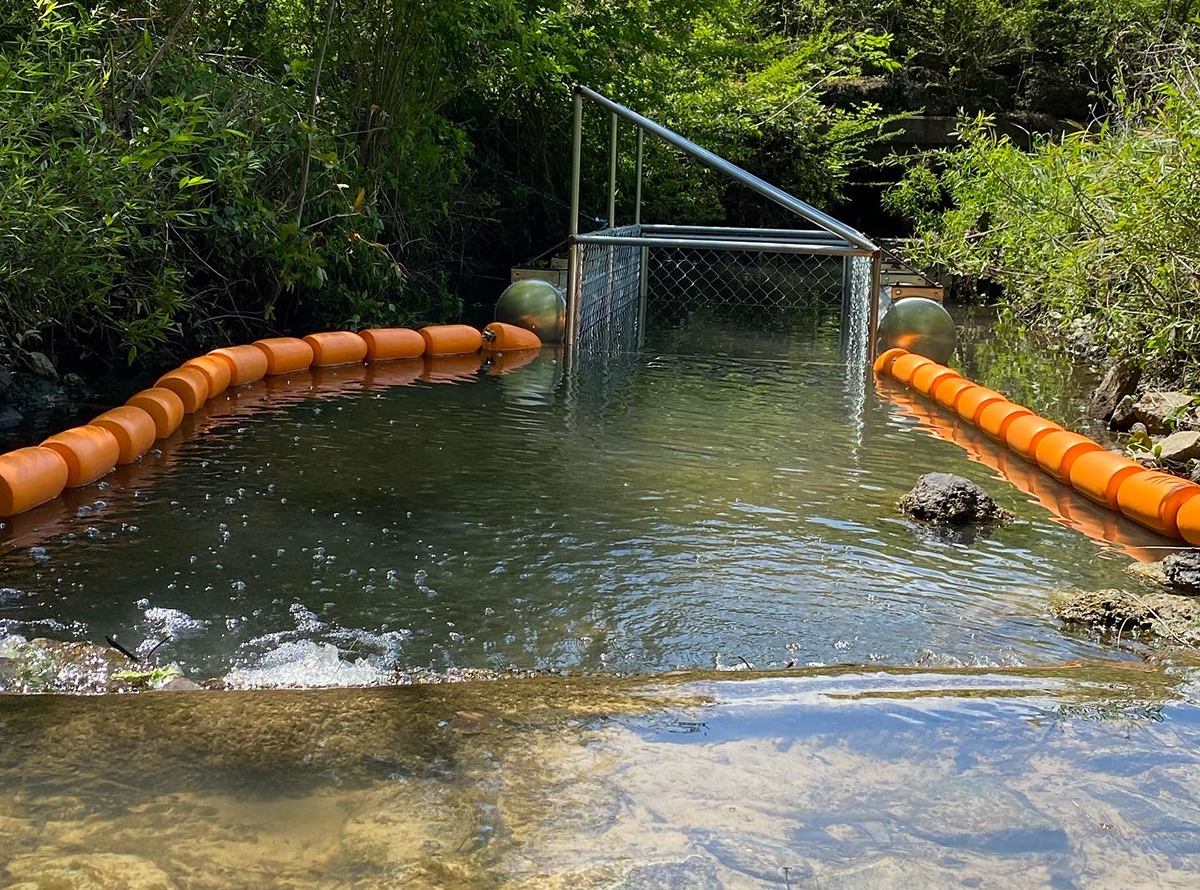
Litter traps are being placed in creeks and rivers throughout the state to catch plastics washing off roadways.
The statewide effort to install Trash Trouts, a device that traps litter in stormwater, is part of a growing effort to lower the amount of macroplastics and microplastics getting into waterways and, eventually, into the ocean.
Supporter Spotlight
Waterkeepers throughout the state will be monitoring the amount of trash collected from the traps and use that information to boost collaborations with local governments to cut down on the amount of plastics making it into the sea and, more importantly, advocates say, curtail consumption of single-use plastics.
“Plastic pollution isn’t a problem we can clean our way out of, although it’s important to get it out of our waterways,” said White Oak Waterkeeper Rebecca Drohan. “We kind of envision the Trash Trouts’ role in that as having data on what sorts of litter, what sources they could possibly be coming from, track that and use that to work with our municipal leaders to inform some of the plastic problems that we’re seeing.”
Coastal Carolina Riverwatch partnered with Jacksonville to install earlier this month a Trash Trout on Scales Creek, a tributary of the New River.
The creek is an unintended recipient of roadside trash, making it an ideal location for a litter trap to catch plastic debris from getting to the Atlantic Ocean.
Trash Trouts were designed by the nonprofit environmental group Asheville GreenWorks. The device works like a metal strainer, capturing and holding trash on the surface of the water.
Supporter Spotlight

The litter traps are funded through a North Carolina Environmental Enhancement Grant as part of a statewide microplastics research and pollution prevention infrastructure project sponsored by Waterkeepers Carolina.
Up to 75% of trash in the nations waterways comes from roadside litter. A majority of that trash is plastics.
When they enter waterways, larger pieces of plastic, referred to as macroplastics, begin to break down into smaller pieces known as microplastics. These tiny pieces of plastic are consumed by marine life and humans.
At least 14 million tons of plastic ends up in the ocean each year, according to the International Union for Conservation of Nature, an organization made up of more than 1,400 government and civil society organizations.
Last year, about 5,500 pounds of trash was rounded up during cleanup efforts throughout the White Oak and New River watersheds, according to Drohan.
The amount of trash collected during cleanups this year overseen by Cape Fear River Watch surpasses that.
“We’re over 6,000 pounds of trash and recycling this year alone and it’s only April,” said Rob Clark, Cape Fear River Watch water quality programs manager.
Roughly 80-85% of the litter collected is plastic of some kind, he said.
The Trash Trout Cape Fear River Watch is installing in Burnt Mill Creek by ARIUM apartments in May will complement litter traps to be placed in storm drains in Wilmington and Leland.
The storm drain devices called LittaTraps, which are catch basins designed by New Zealand-based company Enviropod, are tentatively scheduled to be installed in four locations over the next couple of weeks. The traps were funded by a grant through the Jandy Ammons Foundation.
Related: Project to gauge how well storm drain traps catch litter
In Wilmington, a trap is to be placed in a curbside drain at Waterline Brewing Co. on Surry Street and in a storm drain at the intersection of South Front and Dock streets downtown.
“The idea of the projects is, if we can remove macroplastics from the waterways, we can reduce the levels of microplastics because a lot of microplastics come from macroplastics that break down in the water over time,” Clark said.
A year after the Trash Trout’s installation, river watch will continue sampling and comparing levels of microplastics before and after the trap was placed in the creek. There is a second, controlled site at Island Creek where samples will also be compared.
Two quarts of water will be collected at each location and shipped to the Watauga Riverkeeper in Boone, where water samples are analyzed under a microscope, Clark said.
“Microplastics seems to be a persistent problem globally,” he said. “The structural solutions are super important to collect data and reduce litter levels, but we really need to figure out some source-based reduction because we’re just getting swamped with this stuff. It’s hard to stay on top of the issue without reducing it at the source in some way or another.”
Cutting back at the source was a topic of discussion Friday during the North Carolina Plastic Policy Workshop at the Duke University Marine Lab in Beaufort.
Michelle Nowlin, a clinical professor of law at Duke and co-director of Duke Environmental Law and Policy Clinic headed a session at the workshop discussing policy tools local governments can use to stem the tide of plastic waste going into fresh and marine waters.
Nowlin spoke to Coastal Review a couple of days before the workshop. She said it is incredibly important to draw public attention to litter traps and their effectiveness in reducing the amount of plastic getting into the ocean.
“What we need to do is keep the trash out of the waters to begin with,” she said.
That’s something that can be managed at every level of government, but particularly at the local level.
“The General Assembly has pretty unlimited authority to adopt comprehensive legislation and obviously that would be more effective if they would do so, but the General Assembly has had several bills that various lawmakers have proposed over the years to try to have more effective waste management policies and those have not made it out of committee,” Nowlin said. “Waste management really happens at the local level. Local governments have considerable authority to decide what is the best waste management strategy given the concerns and considerations in our community.”
Nowlin and other researchers have done comprehensive research looking at what other states and cities across the country and national governments throughout the world have done to address plastics in their communities to put together a list of several options local governments here can use.
Those options include everything from banning certain types of single-use plastics by, for example, working with local school districts to rid the use of Styrofoam, to imposing consumer fees on plastic shopping bags, which research indicates is more effective than banning bags outright.
One of the easiest things a local government can do is require vendors it contracts with not use single-use plastics or products contaminated with per- and polyfluoroalkyl substances, or PFAS — think GenX.
“That’s a very easy, straightforward thing that local governments can do and it doesn’t require any new authorizing language,” Nowlin said. “They can decide as Durham County has done that we’re not going to provide single-use plastic water bottles anymore at county-sponsored functions.”







